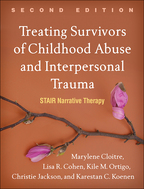Treating Survivors of Childhood Abuse and Interpersonal Trauma
Second Edition
STAIR Narrative Therapy
Marylene Cloitre, Lisa R. Cohen, Kile M. Ortigo, Christie Jackson, and Karestan C. Koenen
The reproducible materials can be downloaded and printed in PDF format.
2. Attachment: When Protector and Perpetrator Are One
3. Development in the Context of Deprivation
II. Foundations of Treatment
4. Treatment Rationale
5. Building Emotional and Social Resources: Overview of STAIR
6. Working with Traumatic Memories: Overview of Narrative Therapy
7. Extending the Narrative: Transforming Shame and Loss
8. Guidelines for Implementing Treatment
9. Assessment of Client and Match for Treatment
III. STAIR Narrative Therapy, Session by Session
- Module I. Skills Training in Affective and Interpersonal Regulation (STAIR): Building Resources
10. Session 1. The Resource of Hope: Introducing the Client to Treatment
11. Session 2. The Resource of Feeling: Emotional Awareness
12. Session 3. Emotion Regulation: Focus on the Body
13. Session 4. Emotion Regulation: Focus on Thoughts and Behavior
14. Session 5. Emotionally Engaged Living: Distress Tolerance
15. Session 6. The Resource of Connection: Understanding Relationship Patterns
16. Session 7. Changing Relationship Patterns: Focus on Assertiveness
17. Session 8. Changing Relationship Patterns: Managing Power
18. Session 9. Changing Relationship Patterns: Increasing Closeness
19. Session 10. Self-Compassion and Summary of Skills Training
- Module II. Narrative Therapy: Facing the Past and Imagining the Future
20. Moving from Skills Training to Narrative Therapy: How Do You Know Your Client Is Ready?
21. Session 11. Introduction to Narrative Therapy
22. Session 12. Narrative of First Memory
23. Sessions 13–17. Narratives of Fear
24. Sessions 13–17. Narratives of Shame
25. Sessions 13–17. Narratives of Loss
26. Session 18. The Final Session
27. New Developments for STAIR Narrative Therapy
References
Index




